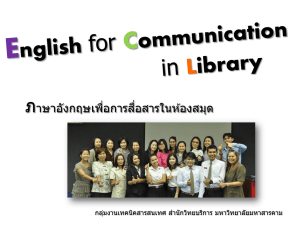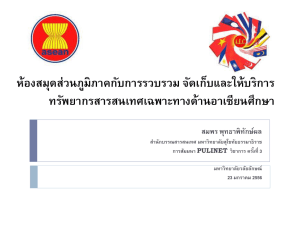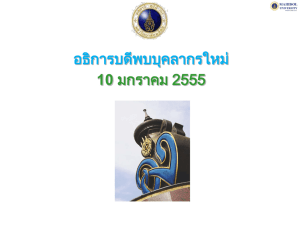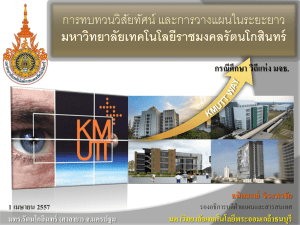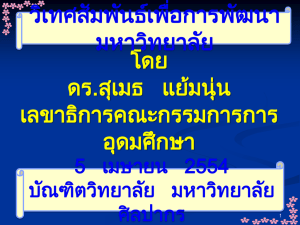Instructional Design for e-Learning - Red5 Test Page
advertisement
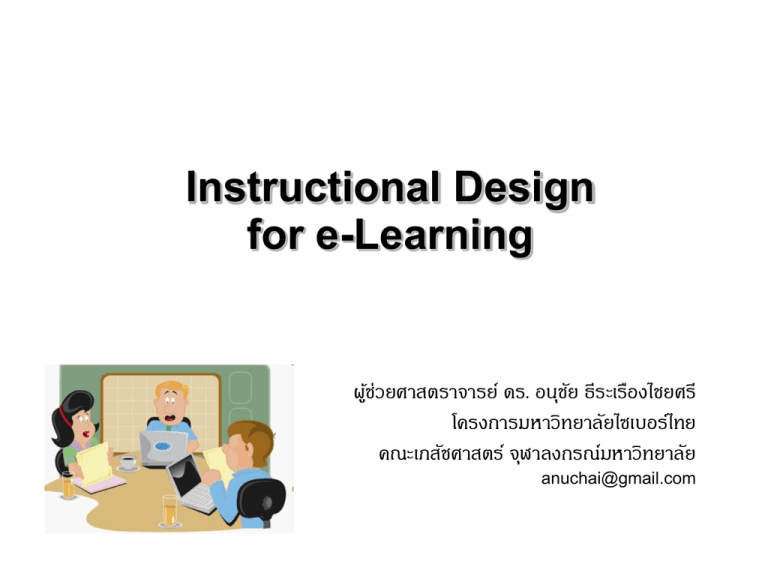
Instructional Design for e-Learning ผูช้ ว่ ยศาสตราจารย์ ดร. อนุชยั ธีระเรืองไชยศรี โครงการมหาวิทยาลัยไซเบอร์ไทย คณะเภสัชศาสตร์ จุฬาลงกรณ์มหาวิทยาลัย anuchai@gmail.com Topics • ห้องเรียนจริง VS ห้องเรียนเสมือน • ID VS e-ID • e-ID Model • ปั จจัยความสาเร็จในการจัดการเรียนการสอนใน ระบบ e-Learning ึ ษา โครงการมหาวิทยาลัยไซเบอร์ไทย สานักงานคณะกรรมการการอุดมศก 2 ลักษณะสำคัญของอีเลิรน์ นิง เอื้อต่อปฏิสมั พันธ์ระหว่างบุคคล และระหว่าง คนกับบทเรี ยนสูง Convenience Time / Place Interaction Open System Multimedia รองรับและแสดงสื่ อ ได้หลากหลาย (สื่ อประสม) เปิ ดสู่แหล่งข้อมูลใน อินเทอร์เน็ตอย่างกว้างขวาง e-learning Syn/Asynchronous Communication Human Driven /Computer Driven Keep log การสื่ อสารแบบสองทางและสื่ อสารพร้อมกันได้ครั้งละหลายคน เก็บบันทึกการเรี ยนและ การสื่ อสารที่ไม่จาเป็ นต้องอยูพ่ ร้อมกัน ในเวลาเดียวกัน ผูส้ ื่ อสาร ประวัติการทางาน สามารถเข้ามาสื่ อสารในเวลาที่สะดวก มีเวลาคิด ึ ษา โครงการมหาวิ ทยาลัยไซเบอร์ไทย สานักงานคณะกรรมการการอุดมศก (การสื่ อสารแบบประสานเวลา/ไม่ ประสานเวลา) รองรับวิธีการจัดการเรี ยนการ สอนที่หลากหลาย -ผูเ้ รี ยนควบคุมการเรี ยน -โปรแกรมควบคุมการเรี ยน 3 ห้องเรียนจริง ? สอน-ถ่ ายทอดความรู้ อาจารย์ ถามคาถาม นักเรียนตอบคาถาม Motivate learner อาจารย์ เฉลย ให้ ข้อมูลป้ อนกลับ Deliver content - Present content - Probe understanding (provide feedback) - Remedial instruction ? Elicit Performance (formative assessment) - Assignment (provide feedback) Summative Assessment - Test (provide feedback) - Evaluation ? การบ้ าน / กิจกรรมการเรียนในชั้นเรียน ึ ษา โครงการมหาวิทยาลัยไซเบอร์ไทย สานักงานคณะกรรมการการอุดมศก 4 ห้องเรียนเสมือน ทีมผลิตสื่ อ Courseware Feedback / Interaction Feedback / Interaction Motivate learner Deliver content - Present content - Probe understanding (provide feedback) - Remedial instruction Elicit Performance (formative assessment) - Assignment (provide feedback) Summative Assessment - Test (provide feedback) - Evaluation -กิจกรรมการเรียนนอกชั้นเรียน -ปฏิสัมพันธ์ หลายหลากแบบ Courseware Feedback / Interaction Feedback / Interaction ึ ษา โครงการมหาวิทยาลัยไซเบอร์ไทย สานักงานคณะกรรมการการอุดมศก 5 ADDIE - Instructional Design Model ึ ษา โครงการมหาวิทยาลัยไซเบอร์ไทย สานักงานคณะกรรมการการอุดมศก 6 Successive Approximation Model for e-Learning based on ADDIE Prototype Background Preparation Design Review Iterative design Implement Develop Evaluate Iterative development Principles: 1. Prototyping (การสร ้างต ้นแบบก่อนการผลิตจริง) 2. Iterative (การเปิ ดโอกาสให ้มีการย ้อนกลับมาทางานซา้ เมือ ่ พบปั ญหา) 3. teamwork (การทางานร่วมเป็ นทีม) 4. Quality assurance (การประกันคุณภาพ) ึ ษา โครงการมหาวิทยาลัยไซเบอร์ไทย สานักงานคณะกรรมการการอุดมศก Michael W. Allen, 2006 7 ADDIE - Instructional Design Model ึ ษา โครงการมหาวิทยาลัยไซเบอร์ไทย สานักงานคณะกรรมการการอุดมศก 8 ึ ษา โครงการมหาวิทยาลัยไซเบอร์ไทย สานักงานคณะกรรมการการอุดมศก 9 กำรออกแบบกำรเรียนกำรสอน (Design) 1. ระบุเป้าหมายของการเรียนรูใ้ ห้ชดั เจน (Specify learning outcome) 2. ระบุประเภทความรู้ (พุทธิพิสยั จิตตพิสยั ทักษะพิสยั ) และระดับ ของความรูท้ ี่ตอ้ งการให้ผเู้ รียนได้รบั (What domain and what level?) 3. เลือกโมเดลการสอน (Model) เลือกยุทธศาสตร์การสอน (Instructional Strategy) วิธีการสอน (Instructional Method) ที่จะ ช่วยให้ผเู้ รียนบรรลุเป้าหมายการเรียนรูท้ ี่กาหนด (Select Model, Instructional Method and Strategy to accomplish your goal) ึ ษา โครงการมหาวิทยาลัยไซเบอร์ไทย สานักงานคณะกรรมการการอุดมศก 10 กำรออกแบบระบบกำรเรียนกำรสอน (Design) 4. กาหนดวิธีการประเมินการเรียนรูท้ ี่สมั พันธ์กบั ยุทธศาสตร์การ สอน (Determine a Assessment Methods) 5. กาหนดกิจกรรมการเรียนการสอน (Design Instructional Events) 6. เลือกเครื่องมือที่จะใช้ในแต่ละกิจกรรมการเรียนการสอน (Select tools to enable each instructional events to meet your strategies) 7. การประเมินการเรียนรู้ (Assess selected outcomes) 8. ประเมินผลสัมฤทธิ์ของกระบวนการเรียนการสอน (Evaluate success of instruction) ึ ษา โครงการมหาวิทยาลัยไซเบอร์ไทย สานักงานคณะกรรมการการอุดมศก 11 Interrelation between Learning goals, Instructional Strategies, Assessment ึ ษา โครงการมหาวิทยาลัยไซเบอร์ไทย สานักงานคณะกรรมการการอุดมศก 12 ึ ษา โครงการมหาวิทยาลัยไซเบอร์ไทย สานักงานคณะกรรมการการอุดมศก 13 Instruction Methods ึ ษา โครงการมหาวิทยาลัยไซเบอร์ไทย สานักงานคณะกรรมการการอุดมศก 14 Instructional Strategy Cognitive Domain (Bloom, 1956) Affective Domain (Krathwohl, Bloom, & Masia, 1973) Psychomotor Domain (Simpson, 1972) Lecture, reading, audio/visual, demonstration, or guided observations, question and answer period 1. Knowledge 1. Receiving phenomena 1. Perception 2. Set Discussions, multimedia CBT, Socratic didactic method, reflection. Activities such as surveys, role playing, case studies, fishbowls, etc. 2. Comprehension 3. Application 2. Responding to phenomena 3. Guided response 4. Mechanism On-the-Job-Training (OJT), practice by doing (some direction or coaching is required), simulated job settings (to include CBT simulations) 4. Analysis 3. Valuing 5. Complex response Use in real situations. Also may be trained by using a several high level activities coupled with OJT. 5. Synthesis 4. Organize values into priorities 6. Adaptation High interest (hard to train to 6. Evaluation 5. Internalizing values these levels because they take more time than normal classroom periods allow). Normally developed on own through self-study or learning through mistakes, but mentoring and coaching can speed the ึ ษา โครงการมหาวิทยาลัยไซเบอร์ไทย สานักงานคณะกรรมการการอุดมศก process. 15 ึ ษา โครงการมหาวิทยาลัยไซเบอร์ไทย สานักงานคณะกรรมการการอุดมศก 16 Expository Model Gagne nine events of instruction ึ ษา โครงการมหาวิทยาลัยไซเบอร์ไทย สานักงานคณะกรรมการการอุดมศก 17 Gagne’s nine events of instruction Gain Attention Media, Questions Inform Learners of Objectives Instructional outcome Stimulate recall of prior learning Graphic organizers, K-W-L, Lesson outline, Brainstroming Present the Content Instructional strategies, Provide examples, Chunk Provide “Learning Guidance” Learning strategies, Recall strategies, Elicit Performance Learning Activities, Practice, Learner Elaborations Provide Feedback Confirm or Correct, Specific, Immediate Assess Performance Summative, Post-Test Enhance Retention and Transfer of the job Experiential Learning, Take-Away, Summaries, Brain Theory ึ ษา โครงการมหาวิทยาลัยไซเบอร์ไทย สานักงานคณะกรรมการการอุดมศก http://www.craigowens.com/gagne/ 18 Cognitive Information Processing ึ ษา โครงการมหาวิทยาลัยไซเบอร์ไทย สานักงานคณะกรรมการการอุดมศก 19 ึ ษา โครงการมหาวิทยาลัยไซเบอร์ไทย สานักงานคณะกรรมการการอุดมศก 20 ผูเ้ รียนท ุกคนมี ควำมแตกต่ำงกัน ึ ษา โครงการมหาวิทยาลัยไซเบอร์ไทย สานักงานคณะกรรมการการอุดมศก 21 Common problem ? Encoding / Rehearsal Sensory motor Short term memory Long term memory Retrieval - ขาดความสนใจระหว่างเรี ยน - เนื้อหามากและสอนเร็วไป (cognitive overload) - ลืม - จาอย่างเดียวไม่เข้าใจ - เนื้อหาซับซ้อน พื้นฐานไม่พอ ไม่เข้าใจ ึ ษา โครงการมหาวิทยาลัยไซเบอร์ไทย สานักงานคณะกรรมการการอุดมศก 22 แบบทดสอบก่อน-หลังการเรียน กิจกรรมการระหว่างเรียน การให ้ข ้อมูลป้ อนกลับทีเ่ หมาะสม Practice, Apply in real world Reflection, Elaboration คาถามแทรก, การให ้ข ้อมูลป้ อนกลับ ข ้อความ ภาพ ภาพเคลือ ่ นไหว ี งทีส ั พันธ์กน เสย ่ ม ั Long term memory (permanent) Solving problem Self-pace, Rehearsal, Learning style คอร์สแวร์บทเรียน E-learning ี ง ภาพ เสย ภาพเคลือ ่ นไหว Sensory motor (ตา หู มือ) ผู ้เรียนควบคุม การทางานบทเรียน อนุชยั ธีระเรื องไชยศรี , 2549 ึ ษา โครงการมหาวิทยาลัยไซเบอร์ไทย สานักงานคณะกรรมการการอุดมศก 23 ึ ษา โครงการมหาวิทยาลัยไซเบอร์ไทย สานักงานคณะกรรมการการอุดมศก 24 Inquisitory: Inquiry-based Learning Hakkarainen, Muukkonen 1998 ึ ษา โครงการมหาวิทยาลัยไซเบอร์ไทย สานักงานคณะกรรมการการอุดมศก 25 Problem-Based Learning ึ ษา โครงการมหาวิทยาลัยไซเบอร์ไทย สานักงานคณะกรรมการการอุดมศก 26 Kolb's Experiential Learning Theory (Kolb, 1984) ึ ษา โครงการมหาวิทยาลัยไซเบอร์ไทย สานักงานคณะกรรมการการอุดมศก 27 Design Learning Activities ผูช้ ว่ ยศาสตราจารย์ ดร. อนุชยั ธีระเรืองไชยศรี โครงการมหาวิทยาลัยไซเบอร์ไทย คณะเภสัชศาสตร์ จุฬาลงกรณ์มหาวิทยาลัย anuchai@gmail.com ึ ษา โครงการมหาวิทยาลัยไซเบอร์ไทย สานักงานคณะกรรมการการอุดมศก 28 กระบวนกำรเรียนร ้ ู Learning from Knowledge PARTICIPATION Share Artifact (Reflective Thought, Concept Map) & Discuss Learning from Knowledge CONSTRUCTION Reflective Thinking, Concept Map Practice Task/Homework Do Project Learning from 29 Knowledge ACQUISITION ึ ษา โครงการมหาวิทยาลัยไซเบอร์ไทย สานักงานคณะกรรมการการอุดมศก Learning activities Goals of learning activities • Let students ACTIVE involve in the knowledge transmission • Let students REFLECTIVE thinking about what they have learned • Let student COLLABORATIVE with their peer to share and interpret the knowledge ึ ษา โครงการมหาวิทยาลัยไซเบอร์ไทย สานักงานคณะกรรมการการอุดมศก 30 Nature of learners • Need safe role (passive and listen) • Individual different (need, knowledge, skill, interest background, etc) • Need motivation (intrinsic and extrinsic) ึ ษา โครงการมหาวิทยาลัยไซเบอร์ไทย สานักงานคณะกรรมการการอุดมศก 31 Learning activities Additional goals of learning activities • Let students get accustom to the learning environment and learning tools • Let students connected (with their peers) to feel safe and comfortable to share • Let students involve in tasks goals and activities • Support and promote learners’ (intrinsic) motivation with external strategies ึ ษา โครงการมหาวิทยาลัยไซเบอร์ไทย สานักงานคณะกรรมการการอุดมศก 32 Learning Activities (Tasks) • • • • • A safe student-centered learning environment The activities is set with students negotiation of the tasks and result described or demonstrated the activities Provide opportunities for communication Provide an expectation of success associated with incorporating the strategy and attitude of engagement is presented • Informative feedback is provided as to the creativity and originality involved in learner actions • Opportunities for self-assessment are provided ึ ษา โครงการมหาวิทยาลัยไซเบอร์ไทย สานักงานคณะกรรมการการอุดมศก 33 Hirumi’s (1996) Eight Events for Student-Centered Learning 1.0 2.0 3.0 4.0 5.0 6.0 7.0 8.0 Set Learning Challenge for Class Negotiate Learning Goals and Objectives Negotiate Learning Strategy Construct Knowledge Negotiate Performance Criteria Assess Learning (Self, Peer & Expert) Provide Feedback (Throughout Steps 1-6) Communicate Results ึ ษา โครงการมหาวิทยาลัยไซเบอร์ไทย สานักงานคณะกรรมการการอุดมศก 34 Phase of engagement (connected) Social Negotiator (week 1-2) - Provides activities that are interactive and help learners get to know one another. - Instructor express expectations for engagement in the course - Keeps learners on track Newcomer Cooperator Initiator / Partner Collaborator ึ ษา โครงการมหาวิทยาลัยไซเบอร์ไทย สานักงานคณะกรรมการการอุดมศก 35 Phase of engagement Newcomer Cooperator Initiator / Partner Collaborator ึ ษา โครงการมหาวิทยาลัยไซเบอร์ไทย สานักงานคณะกรรมการการอุดมศก Structure engineer (week 3-4) - Instructor forms dyads of learners and provides activities that require critical thinking, reflection, and sharing of ideas 36 Phase of engagement Newcomer Initiator / Partner Cooperator Collaborator ึ ษา โครงการมหาวิทยาลัยไซเบอร์ไทย สานักงานคณะกรรมการการอุดมศก Facilitator (week 5-6) - Instructor provides activities that require small groups to collaborate, solve problems, reflect on experiences. 37 Phase of engagement Newcomer Community member/ Challenger (week 7-16) - Activities are learnerdesigned or learnerled. Discussion beginInitiator to go not only where the instructor intends but also where the learners direct them to go / Partner Cooperator Collaborator ึ ษา โครงการมหาวิทยาลัยไซเบอร์ไทย สานักงานคณะกรรมการการอุดมศก 38 ปัจจัยควำมสำเร็จในกำรเรียนกำรสอนระบบ e-Learning ผูช้ ว่ ยศาสตราจารย์ ดร. อนุชยั ธีระเรืองไชยศรี โครงการมหาวิทยาลัยไซเบอร์ไทย คณะเภสัชศาสตร์ จุฬาลงกรณ์มหาวิทยาลัย anuchai@gmail.com ึ ษา โครงการมหาวิทยาลัยไซเบอร์ไทย สานักงานคณะกรรมการการอุดมศก 39 สั มฤทธิผลในการเรียน เกิดการเรียนรู้ เจตคติทดี่ ี บทเรียน / ประสบการณ์ ในการเรียนรู้ หลักสู ตร การช่ วยเหลือ / แนะนาในการเรียน บทบาทผู้สอน แรงจูงใจในการเรียน ความเข้ าใจในวิธีการเรียน กิจกรรมการเรียน ไม่ เลิกเรียนกลางครัน แรงจูงใจภายใน (Goal, Interest, Belief/Attitude Past experience, Skills) แรงจูงใจภายนอก (Score, Pride, Recognized Socialization) ึ ษา โครงการมหาวิทยาลัยไซเบอร์ไทย สานักงานคณะกรรมการการอุดมศก 40 Conditions for learning Prior knowledge Authentic / Contextual Learner Active Learning Learning Learner Characteristics Motivation Knowledge retention Rich Interaction (Learner-Content, Learner-Teacher, Learner-Peer) ึ ษา โครงการมหาวิทยาลัยไซเบอร์ไทย สานักงานคณะกรรมการการอุดมศก Knowledge Application Learned Knowledge Transfer Satisfaction 41 สภำพแวดล้อมกำรเรียนกำรสอนอีเลิรน์ นิง Context สื่ อและกระบวนการผลิตสื่ อการสอน กระบวนการผลิต สื่ อการศึกษา Key content Association การส่ งผ่านสารสนเทศและสื่ อการสอ สื่อการศึกษาหลัก Coordinated media Attention and Focus สื่ อเสริ ม Motivation Organization of Knowledge การสื่อสาร / ปฏิสัมพันธ์ ผู้สอน การสื่ อสารและปฏิสมั พันธ์ทางการเรี ยน กิจกรรมการเรี ยน / ข้อมูลป้ อนกลับ การวัดและการประเมินผล การประเมินผล ผู้เรียน Practice Capacity Learning styles and ability ลักษณะผูเ้ รี ยนและ พฤติกรรมการเรี ยน ึ ษา โครงการมหาวิทยาลัยไซเบอร์ไทย สานักงานคณะกรรมการการอุดมศก ระบบการส่ งผ่านสารสนเทศและการสื่ อสาร (LMS and Communication tools)42 Motivation Guidelines for motivating e-learners • Motivate learners first, last, and always! • Never assume learners are already motivated. • Tie learning to promotion. • Certify learning accomplishments. • Gifts, prizes, trinkets. • Explain how it makes the job easier. • • • • • Provide options on how to learn. Provide time for learning. Ease anxiety. Opportunities for meaningful application. Flexibility in projects for application. ึ ษา โครงการมหาวิทยาลัยไซเบอร์ไทย สานักงานคณะกรรมการการอุดมศก 43 Key content Guidelines for selecting and featuring key content • Teach learners to answer their own questions. • Resist teaching large amounts of detailed factual information. • Put it online. • Don't be afraid of giving printed material. • Summarize in a job aid. • Paper or online. • Ask former learners. • • • • • • • • Focus on what is hard to learn on your own. Pretest. FAQs. Anticipate problem areas. Listen to your e-mail. Listen to focus group. Listen to SMEs and other content experts. Tech support too. Have novices evaluate. ึ ษา โครงการมหาวิทยาลัยไซเบอร์ไทย สานักงานคณะกรรมการการอุดมศก 44 Associations Guidelines for associating essential ideas with triggers for their recall • • • • • • • • Provide rich associations for key concepts. Do not rely solely on simple pick-one tests. Multiple triggers. Use images. Active. Dynamic. Sound. Give the big picture. Tell a story. Involve emotion. Analogies and metaphors. Familiar ones. Practice! ึ ษา โครงการมหาวิทยาลัยไซเบอร์ไทย สานักงานคณะกรรมการการอุดมศก 45 Capacity Guidelines to avoid overloading learners • Do not require learners to keep more than a few items in memory at a time. • Group items into categories that are relevant to what you are teaching and meaningful to learners. • Give opportunities for application & consolidation. • Ask people to summarize or abstract. • Practice. • Give the big picture. • Explain terms. Glossary or pop-up definition. • Simplify the user-interface. ึ ษา โครงการมหาวิทยาลัยไซเบอร์ไทย สานักงานคณะกรรมการการอุดมศก 46 Organization of knowledge Guidelines for sequencing and structuring content • Show the organization of any group of more than a few items. • Never bury something crucial in the middle. • Show organization visually: org chart, flow chart, etc. • Avoid paragraphs longer than 3 sentences. • Instructions on how to navigate. Make optional. • Use styles consistently and moderately. ึ ษา โครงการมหาวิทยาลัยไซเบอร์ไทย สานักงานคณะกรรมการการอุดมศก 47 Learning styles and abilities Guidelines for catering to the different ways people learn • Provide multiple ways for people to learn crucial ideas. • Use media to focus attention on what you are teaching, never to distract. • W3C Web Accessibility Guidelines • Design for slow reader; options for faster readers. • Review for cultural issues. • Get permission or get digital rights. ึ ษา โครงการมหาวิทยาลัยไซเบอร์ไทย สานักงานคณะกรรมการการอุดมศก 48 Attention and focus Guidelines for ensuring learners attend to what they need to learn • • • • • • • • • Focus attention on the most important thing you are teaching. Forego meaningless "whoopie-cushion" multimedia. Simplify, prune, edit. Use only a few colors, fonts, textures, etc. Use muted colors. Earth tones. Simple font. Sans serif? Do not overload display. Lots of white space. Widely available fonts. Short lines and paragraphs. 6x6 rule. ึ ษา โครงการมหาวิทยาลัยไซเบอร์ไทย สานักงานคณะกรรมการการอุดมศก 49 Context Guidelines for making clear how what you are teaching fits into the whole • Provide the context for all new information introduced. • Make the context of learning resemble that in which skills and knowledge will be applied. • Maps with you-are-here highlighted. • Table of contents. • Fill-in-the-blanks procedures. • Rewards for partial completions. • Completion bars. • Page 1 of 7. • Tell time to complete. ึ ษา โครงการมหาวิทยาลัยไซเบอร์ไทย สานักงานคณะกรรมการการอุดมศก 50 Practice Guidelines for providing learners with opportunities for meaningful practice • • • • • • • • • Help learners practice everything they should learn. Let learners decide how much practice is enough. Let learners experiment. Practice right after learning. Mini-practices. Where to go next ... for real-world practice. Get people talking. Ensure success. Authentic feedback. Do not hide the right answer forever. ึ ษา โครงการมหาวิทยาลัยไซเบอร์ไทย สานักงานคณะกรรมการการอุดมศก 51 Coordinated media Guidelines for combining media for crucial messages • Do not require learners to attend to more than one visual and one audible item at a time. • Present consistent messages in different media. • Include media that everyone can play. • Read system requirements. ึ ษา โครงการมหาวิทยาลัยไซเบอร์ไทย สานักงานคณะกรรมการการอุดมศก 52 Evaluation “The purpose of evaluation is not to prove but to improve.” This quote from the fly-leaf of the Phi Delta Kappa books states positively the goal of evaluation ึ ษา โครงการมหาวิทยาลัยไซเบอร์ไทย สานักงานคณะกรรมการการอุดมศก 53 แนวคิดกำรประเมินผลกำรเรียนร ้ ู (ย ุคใหม่) กำรประเมินตำมแนวคิดเดิม • ผูเ้ รียนเป็ นผูถ้ กู กระทา • การประเมินแยกจากการเรียนการสอน • • • • ประเมินเพื่อตัดสินผลการเรียนของผูเ้ รียน ประเมินจากการตอบข้อสอบ ผูถ้ กู ประเมินเป็ นผูเ้ รียนรายบุคคล ประเมินสาระที่เรียนรู้ (product) กำรประเมินตำมแนวคิดใหม่ • เน้นผูเ้ รียนเป็ นผูก้ ระทา • การประเมินเป็ นส่วนหนึง่ ของการเรียน การสอน • ประเมินเพื่อพัฒนาผูเ้ รียน • การประเมินด้วยวิธีการที่หลากหลาย • ประเมินผูเ้ รียนทัง้ รายบุคคล/เป็ นกลุม่ • ประเมินสาระที่เรียนรู้ (product) พัฒนาการด้านความรู้ (progress) พัฒนาการกระบวนการเรียนรู้ (process) ึ ษา โครงการมหาวิทยาลัยไซเบอร์ไทย สานักงานคณะกรรมการการอุดมศก 54 ช่วงเวลำของกำรประเมิน • ประเมินก่อนเริ่มต้นการเรียนการสอน (pre-test) เพื่อจัดวางตาแหน่ง ผูเ้ รียน หรือประเมินความรู/้ ทักษะพื้นฐานของผูเ้ รียนก่อนเริ่มกิจกรรม เป็ น สารสนเทศในการวางแผนจัดกิจกรรมการเรียนการสอนให้เหมาะสม • ประเมินระหว่างการเรียน (Formative Assessment) เพื่อตรวจสอบความรู้ ความสามารถ และทักษะในขณะที่ยงั เรียนอยู่ เพื่อได้สารสนเทศย้อนกลับที่ เป็ นประโยชน์ตอ่ การติดตามความก้าวหน้าหรือพัฒนาการในการเรียนรู้ ตลอดจนจุดบกพร่องในการเรียน • ประเมินหลังสิ้นสุดการเรียน (Summative Assessment) เพื่อสรุปผลการ เรียนรูข้ องผูเ้ รียน เพื่อได้สารสนเทศที่เป็ นประโยชน์ตอ่ การตัดสินใจ พัฒนาการและระดับสัมฤทธิผลของผูเ้ รียน ึ ษา โครงการมหาวิทยาลัยไซเบอร์ไทย สานักงานคณะกรรมการการอุดมศก 55 สิ่งที่ประเมิน • สาระที่เรียนรู้ (product) ผูเ้ รียนเรียนรูอ้ ะไร สามารถทาอะไรได้ ประเมินหลังสิ้นสุดการเรียน • พัฒนาการด้านความรู้ (progress) ผูเ้ รียนมีวิธีการเรียนรูอ้ ย่างไร ประเมินก่อนการเรียน ประเมินระหว่างการเรียน • พัฒนาการกระบวนการเรียนรู้ (process) ผูเ้ รียนมีพฒ ั นาการจากเดิมเท่าไร ประเมินระหว่างการเรียน ึ ษา โครงการมหาวิทยาลัยไซเบอร์ไทย สานักงานคณะกรรมการการอุดมศก 56 วิธีกำรประเมิน • วิธีการประเมินด้วยข้อสอบ (แบบทดสอบต่างๆ) • วิธีการประเมินด้วยการสื่อสารส่วนบุคคล (บันทึกการถามตอบใน ชัน้ เรียน บันทึกการอภิปรายในชัน้ เรียน บันทึกเหตุการณ์ของ ผูเ้ รียน) • วิธีการประเมินจากสภาพจริง การประเมินจากพอตโฟลิโอ (portfolio) • วิธีการปฏิบตั ิ ึ ษา โครงการมหาวิทยาลัยไซเบอร์ไทย สานักงานคณะกรรมการการอุดมศก 57 กำรประเมินผลด้วยกำรสื่อสำรส่วนบ ุคคล การติดต่อสื่อสาร และแลกเปลี่ยนข้อมูลความรู้ ความเข้าใจ ความ คิดเห็นระหว่างผูเ้ รียน หรือผูเ้ รียนกับผูส้ อน ในกระบวนการเรียนการ สอนเพื่อเป็ นประโยชน์ตอ่ สัมฤทธิ์ผลทางการเรียน และตอบสนองต่อ จุดมุง่ หมายการเรียนรูท้ ี่หลากหลาย เพื่อเป็ นการสนับสนุนให้ผเู้ รียนมี การพัฒนาปรับปรุงให้สามารถเรียนรูไ้ ด้เต็มศักยภาพ โดยให้ความ สนใจต่อข้อมูลสารสนเทศของผูเ้ รียนรายบุคคลและรายกลุม่ เช่น การถามตอบในชัน้ เรียน การพบปะพูดคุยกับผูเ้ รียน การ อภิปรายในชัน้ เรียน การบันทึกเหตุการณ์ของผูเ้ รียน ึ ษา โครงการมหาวิทยาลัยไซเบอร์ไทย สานักงานคณะกรรมการการอุดมศก 58 เครื่องมือในกำรประเมินกำรเรียนรใ้ ู น e-learning • วิธีการประเมินด้วยแบบทดสอบ แบบทดสอบประเภทต่างๆ (แบบตัวเลือก แบบจับคู่ แบบตอบคาถามสัน้ ๆ ฯลฯ) แบบสอบถามความคิดเห็น (Survey) • วิธีการประเมินด้วยการสื่อสารส่วนบุคคล กระดานสนทนา web board ห้องสนทนา chat room • วิธีการประเมินจากสภาพจริง การประเมินจากพอตโฟ ลิโอ (portfolio) เครื่องมือบันทึกความรู้ ความคิดต่อเนือ่ ง (Weblog) เครื่องมือการส่งงานและปรับปรุงงาน (e-portfolio) เครื่องมือสร้างงานร่วมกัน (Wiki) ึ ษา โครงการมหาวิทยาลัยไซเบอร์ไทย สานักงานคณะกรรมการการอุดมศก 59 เทคนิคกำรประเมินด้วยกำรสื่อสำรส่วนบ ุคคล • ออกแบบกิจกรรมการเรียนที่จะกระตุน้ ให้ผเู้ รียนได้คิด และแสดง ความคิดเห็น • กระตุน้ ให้มกี ารแลกเปลี่ยนความคิดเห็นระหว่างกัน • ผูส้ อนอาจจะมีสว่ นร่วมในบางระดับ ในลักษณะการส่งเสริมการ แสดงความคิดเห็น กระตุน้ ความคิด • ระบบจัดการเรียนการสอน (LMS) จะสรุปการแสดงความคิดเห็นของ ผูเ้ รียนแต่ละคน เพื่อการติดตามประเมินได้งา่ ย ึ ษา โครงการมหาวิทยาลัยไซเบอร์ไทย สานักงานคณะกรรมการการอุดมศก 60 เทคนิควิธีกำรประเมินจำกสภำพจริง • เป็ นการประเมินเชิงคุณภาพอย่างต่อเนือ่ งในด้านความรู้ ความคิด พฤติกรรม วิธีการปฏิบตั แิ ละผลการปฏิบตั ขิ องผูเ้ รียนทีแ่ ท้จริง • วิธีการประเมิน ได้แก่ การสังเกต การสัมภาษณ์ บันทึกจาก ผูเ้ กี่ยวข้องแบบทดสอบวัดความสามารถจริง การรายงานตนเอง และแฟ้มสะสมงาน (Portfolio) เครื่องมือใน e-learning • เครื่องมือบันทึกความรู้ ความคิดต่อเนือ่ ง (Weblog) • เครื่องมือการส่งงานและปรับปรุงงาน (e-portfolio) • เครื่องมือสร้างงานร่วมกัน (Wiki) 61 ึ ษา โครงการมหาวิทยาลัยไซเบอร์ไทย สานักงานคณะกรรมการการอุดมศก Arrange Team in E-Learning Courseware Feedback / Interaction Thesis Advisor Feedback / Interaction Instructor(s) Learning Facilitator Peer Technical Support Academic Advisor ึ ษา โครงการมหาวิทยาลัยไซเบอร์ไทย สานักงานคณะกรรมการการอุดมศก 62 Program Committees ขอบคุณทุกท่าน.. ึ ษา โครงการมหาวิทยาลัยไซเบอร์ไทย สานักงานคณะกรรมการการอุดมศก 63 คาถาม ึ ษา โครงการมหาวิทยาลัยไซเบอร์ไทย สานักงานคณะกรรมการการอุดมศก 64
